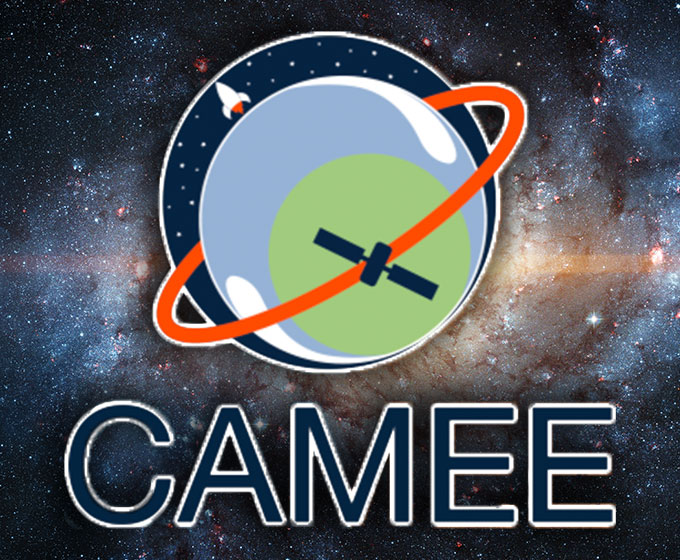
MARCH 11, 2022 — Undergraduate, master’s and doctoral students pursuing degrees in science and engineering will present their research today at the UTSA Center for Advanced Measurements in Extreme Environments (CAMEE) Student Research Spring Showcase. The event is free and open to the public. It will be held in the Biotechnology, Sciences and Engineering Building (BSE 3.03.02).
CAMEE was established at UTSA in 2019 to encourage interdisciplinary academic collaboration at UTSA. The center, funded by NASA’s Minority University Research and Education Project and led by Kiran Bhaganagar, a UTSA professor of mechanical engineering, fosters research partnerships between the university’s Margie and Bill Klesse College of Engineering and Integrated Design and its College of Sciences to tackle leading challenges related to earth system sciences, remote sensing technologies, computational fluid dynamics and experimental fluid mechanics.
These research areas are of significant importance for interventions related to adapting to or combating climate change and to further capacity for space exploration.
Today’s event will provide graduate students with an opportunity to summarize their theses and dissertations in three minutes or less while enabling undergraduate students to present their research in a poster format.
"This event is a great opportunity for students to polish and demonstrate their communication skills,” said Bhaganagar. “Being able to communicate effectively is a huge part of interdisciplinary success. It allows those with different research focuses to ensure a mutual understanding.”
The research on display will include aerodynamics, atmospheric science and extreme events, the Gulf of Mexico and polar oceans, modeling, simulation and big data, volcanoes, high speed aerodynamics, sea ice and rising sea levels. Participating students are eligible for cash prizes, with top presenters receiving $200.
“It is important for CAMEE to foster a learning and research environment that equips our students, many of whom come from historically underrepresented backgrounds, with the technical knowledge and framework to support the critical work of NASA and similar agencies,” said Bhaganagar.
Student involvement is a key aspect of CAMEE’s mission. Students involved in CAMEE’s research projects have the opportunity to work with UTSA faculty in disciplines such as atmospheric sciences, geography, earth and planetary sciences, mechanical engineering, civil engineering and electrical engineering.
Currently, a group of undergraduate researchers are working on a project to 3D-print a Mars Rover. The center developed a test-site including 20 square meters of ground simulating operating conditions for testing the student-developed rover’s capabilities. The center also actively collaborates with the Alamo Colleges and the University of Texas Rio Grande Valley to develop wider knowledge networks and foster local growth in these research areas.
Those involved in CAMEE have seen significant success over its relatively short existence. Several students have parlayed their time at CAMEE into internships with NASA. Iyare Oseghae, a second-year graduate student studying geoinformatics, turned his research on using drones to monitor wildfires into an internship at NASA’s Jet Propulsion Laboratory (JPL). He recently received a job offer from Sandia National Laboratories, one of the leading national security research facilities in the United States. He is currently deciding whether to pursue this path or a Ph.D.
Another student who saw success through CAMEE is mechanical engineering Ph.D. graduate Sudheer Bhimireddy ’20. Bhimireddy developed a numerical simulation of physics-based equations to help researchers simulate wildfires. The project, which helps researchers better predict the intensity and direction of wildfires (such as those that have recently impacted California) led to a post-doc research position at the University of Illinois at Urbana-Champagne (UIUC) and, ultimately, a position with UIUC’s research faculty.
UTSA Today is produced by University Communications and Marketing, the official news source of The University of Texas at San Antonio. Send your feedback to news@utsa.edu. Keep up-to-date on UTSA news by visiting UTSA Today. Connect with UTSA online at Facebook, Twitter, Youtube and Instagram.
Move In To COLFA is strongly recommended for new students in COLFA. It gives you the chance to learn about the Student Success Center, campus resources and meet new friends!
Academic Classroom: Lecture Hall (MH 2.01.10,) McKinney Humanities BldgWe invite you to join us for Birds Up! Downtown, an exciting welcome back event designed to connect students with the different departments at the Downtown Campus. Students will have the opportunity to learn about some of the departments on campus, gain access to different resources, and collect some giveaways!
Bill Miller PlazaJoin us for an intimate evening of cocktails, conversation, and culinary inspiration with Pati Jinich, Emmy-nominated chef and James Beard Award-winning author. Enjoy light bites and signature drinks in the warm, modern setting of Mezquite as Pati connects with guests over her passion for Mexican cuisine and storytelling.
Mezquite Restaurant in Pullman Market, 221 Newell Ave., San Antonio 78215From inspired courses to thoughtful pairings and a rich sense of community, the Ven a Comer Signature Dinner is a night of shared meals, shared stories, and unforgettable flavor.
Stable Hall (Pear Brewery), 307 Pearl Pkwy, San Antonio 78215Come and celebrate this year's homecoming at the Downtown Campus with food, games, giveaways, music, and more. We look forward to seeing your Roadrunner Spirit!
Bill Miller PlazaThe University of Texas at San Antonio is dedicated to the advancement of knowledge through research and discovery, teaching and learning, community engagement and public service. As an institution of access and excellence, UTSA embraces multicultural traditions and serves as a center for intellectual and creative resources as well as a catalyst for socioeconomic development and the commercialization of intellectual property - for Texas, the nation and the world.
To be a premier public research university, providing access to educational excellence and preparing citizen leaders for the global environment.
We encourage an environment of dialogue and discovery, where integrity, excellence, respect, collaboration and innovation are fostered.